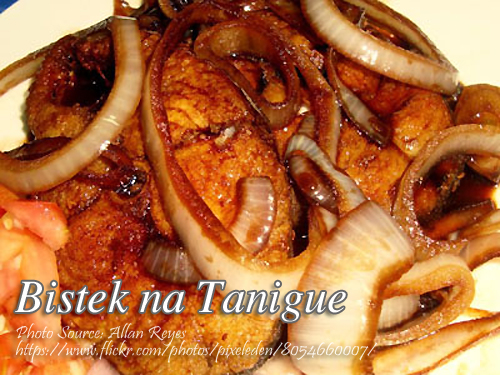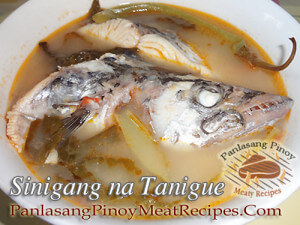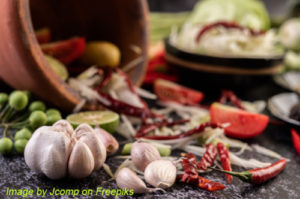Bistek is actually a Filipino version of beef steak marinated and cooked with soy sauce and is not the grilled steak which is popular in western cooking. The bistek version I have here used tanigue or Spanish mackerel fish steaks as a substitute to beef. So the next time you are in the market and saw tanigue steaks and don’t know how to cook it, this recipe might be worth a try.
Bistek na Tanigue: Bringing Family Memories to the Table
There’s something reassuringly plebeian about the smell of bistek wafting from the kitchen. The dish is, after all, one that instantly transports me back to family gatherings at my Lola’s house, with the clinking of utensils and soft chatter of relatives against the backdrop of a slow-cooked meal. Of course, this time I’m talking about Spanish mackerel and soy sauce instead of the usual beef bistek. Instead, I am introducing you to a happy twist on this popular Filipino dish—one that would replace the usual beef slices with thick, juicy slices of tanigue, or Spanish mackerel.
Still, I remember the first time I had this version of bistek. It was during the birthday celebration of my Uncle Jun in Cavite. A fisherman by profession, his wife Tita Sol would always discover ways and means of presenting the catch in the kitchen. On one given evening instead of that feast of beef or pork dishes, Tita Sol had brought home this delicious bistek from fresh tanigue steaks. The way the fish was placed on my taste buds proved it to be a buttery rich flavor topped with some great savory-sweet sauce. It got me.
The New Filipino Delicacy
The pinoy love Bistek or bistek Tagalog which is a popular Filipino delicacy that’s basically sautéed sliced meat in a savory, salty, and slightly sweet sauce made from soy sauce and kalamansi. Traditionally, beef was being used to contain this dish however, when most of the Filipino household do it nowadays, part of the ingredients is usually swapped with what is in season or what’s available for use. Fish is also an alternative, and a possible candidate for this would be tanigue, a Spanish mackerel species that is valued for its firmness and its mild flavor.
The fish is seasoned first, then fried in a pan till crispy and golden brown. This is then simmered in a sauce that is balanced between soy sauce, fresh kalamansi juice squeezed from the lime fruits, and a hint of sugar to mellow out its acidity. Every bite will be delightful as it introduces the natural richness of the fish and the bold, tangy character of the sauce.
The Story Behind the Dish
Anyway, the use of fish in bistek isn’t a new thing at all. Many coastal areas in the Philippines have actually used tanigue or whatever local fish is available there instead of beef. That’s one form of years-old adaptation that has been passed on from generation to generation to relate the resourcefulness and creativity of Filipino home cooks.
I remember my mother, Maria, telling me how they would cook something similar when she was still a little girl in Cebu. As beef was not always accessible to them, fish was the next best alternative. “Your Lolo would catch tanigue in the early mornings,” she would say, “and your Lola would quickly whip up a bistek dish before the fish lost its freshness.” How wonderful these little anecdotes are, making every single bite of our food even more meaningful.
Choosing the Right Fish for the Dish
In making this recipe, one should pick steaks that are firm and fresh. Tanigue is preferred because of its dense texture that holds very well with pan-frying and simmering. However, in other places, bangus (milkfish) or tilapia could also be used; yet, theirs would be different in texture and taste. The fish to be picked should be of a type that would not easily flake apart and also absorb deep flavors provided by the sauce.
The frying process is where the fish develops that subtle golden crust, contributing to the flavor and texture. My cousin, Ana, from Davao prefers to dust the fish lightly with flour before frying it so that it yields extra crispness on the outside. It is such minute differences in cooking methods that make every family’s version unique.
Getting the Sauce Right
Actually, one of the most essential components of the bistek dish is this ingredient. The sauce is quite simple-made of soy sauce and kalamansi juice. To be truthful, finding the right mix, however, requires practice. When there is too much soy sauce, it’s too salty. Too much kalamansi, it’s sour. A little sugar does the trick in adjusting the whole mix to harmony.
If you can’t get kalamansi, lemon or lime juice can be used as alternatives, although their amounts may need to be increased as they are less sweet and more acidic than kalamansi. My sister Lea, who has been in Canada for a few years now, shared how she had to experiment a little before she got the proper amount of lemon juice and sugar to get that nostalgic tangy flavor we all are fond of.
A Dish for Sharing
Bistek na tanigue exceeds the recipes. It is proof of the flexibility towards Filipino dishes and resourcefulness by cooks of Filipino descent. It is a dish about unifying people with families around the dinner table, with the remnants of home-cooked meal memories and lively dinner sessions.
No matter the occasion, be it your daily meal for the week or for that special celebration, this recipe will easily become a favorite in your household. Easy to make with only a few ingredients and yet bursting with flavor, it goes well served with steamed rice, and watch how your family digs in and savors every last morsel of this scrumptious take on a classic Filipino dish.
It’s not just recipes, after all; it’s pieces of you in each dish. For me, this bistek na tanigue will always remind me of my family-the afternoons spent in our old house in Cavite, watching Tita Sol prepare the meal, and all these moments of laughter around the dinner table. For me, it’s these memories that make every meal, no matter how simple, really special.
How to Cook Spanish Mackerel Steaks in Soy Sauce (Bistek na Tanigue)
Ingredients
- 1 kilo Tanigue Steaks or Spanish Mackerel Steaks
- 1 pc big white onion sliced into rings
- 1/4 cup soy sauce
- 1/4 cup kalamansi or lemon juice
- 1 Tbsp. sugar
- 1/2 head garlic minced
- cooking oil
- rock salt to taste
Instructions
How to cook bistek na tanigue:
- Rub tanigue steaks with salt and fry until golden brown.
- Transfer to a plate or container and set aside.
- Heat a tablespoon of cooking oil in a pan and saute garlic and onion.
- Then add the soy sauce and kalamansi juice.
- Mix with sugar until the sauce becomes balanced with sweet, sour and salty taste.
- Adjust the soy sauce, sugar and kalamansi until you got the desired result.
- Let it simmer for a few seconds then add the fried tanigue steaks.
- Simmer at least 2 minutes and then serve hot.
Notes
Cooking Tips:
Fish Fresh Select
For best results, choose fresh tanigue with firm texture, mild, and clean smell. The eyes are clear, shiny moist skin, which means freshness. Avoid using dull or fishy-smelling steaks, as these indicate that the fish is no longer fresh.Balancing the Sauce
The game, then is perfect sauciness. And so, I started with the soy sauce and kalamansi juice, putting a little amount and tasting and adjusting it in order to reach that perfect taste for tanginess, saltiness, and sugar. If it is too sour, a bit of sugar can help neutralize the acidity.Do not Overcook the Fish
Since tanigue is quite firm in texture, overcooking occurs if held too long in the pan. Fry these steaks until golden brown. Remove immediately from the pan. With the sauce, only a few minutes of cooking time are allowed to retain that tender and moist quality.






What do you serve on the side with this?
It is usually served with rice.
Can I cook this without frying the fish?
Hi Delza, you can cook it without frying the fish but it will taste fishy and will crumble to pieces when you cook it with the sauce.
I’m glad I found your bistek na tanigue recipe! I plan to cook it tonight. Thanks!
Hi Theresa, I’m also glad you found this recipe! Cheers!